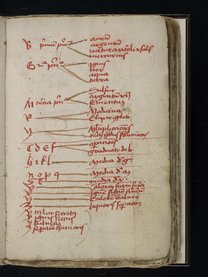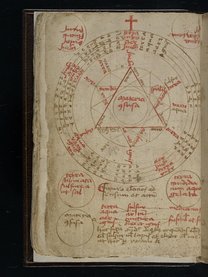Codicillus
- Circa 1470 – 1500 (Part two)
- 1472 (Part one)

Rights
Download all 226 images
PDFZIPof full-sized JPGsDownload selected image
Small JPG1200 x 1596px — 504 KBLarge JPG2880 x 3829px — 2.6 MBFull-sized JPG3179 x 4227px — 3.1 MBOriginal fileTIFF — 3179 x 4227px — 38.5 MBCopy of an early text from the Pseudo-Lullian alchemical corpus, assembled before the sixteenth century from two independent manuscripts. This manuscript is noteworthy for its illustrations, tables, figures, and extensive annotations. The work was possibly owned by Carlo Maria Buonaparte (1746-1785), father of the Emperor, Napoleon, as is suggested by the signature located on the work's flyleaf.
The manuscript consists of two parts. The first, which includes the end of the text by Pseudo-Lull and diagrams, is dated 1472. The script and initials suggest an origin in northern Italy, or perhaps in a neighboring region of Germany or Austria. The second part includes the bulk of the Pseudo-Lull text from the beginning, breaking off where the first part picks up. It is copied in an Italian cursive humanistic script from the second half of the fifteenth century. It is undetermined whether the manuscript was assembled from two pre-existing manuscripts of completely independent origins, or if the first section of the manuscript was copied to supply text missing at the end of this section.
Both sections are annotated with occasional notes, pointing hands, and underlined sections of text in black ink by a later, possibly sixteenth-century, reader. The wear on the two sections appears to be independent.
The text is presented as a compendium of the secrets of nature. The opening chapters discuss the relationship between the micro and macrocosm, the bond of love uniting the world, and the need for reformatiomateriae (a reformation of matter that can be achieved by the true alchemist who receives illumination from God). A practical section begins in chapter twelve and includes a detailed discussion of the four stages of the alchemical opus, described in terms of the generation of the human body.
The Codicillus is considered to be one of the most important of the pseudo-Lullian alchemical works, a large collection of as many as 143 different texts that circulated as the work of Raymond Llull (1232-1316), the Catalan philosopher, theologian, and mystic. It is now well-accepted that none of the alchemical texts are authentic works by Llull. Despite Llull's reputation as an alchemist, he speaks of alchemy negatively in his authentic works, and none of the alchemical texts associated with him date from his lifetime.
| Property | Value |
|---|---|
| Author | |
| Provenance |
Belonged to Joost R. Ritman (b. 1941), the Dutch businessman and distinguished collector of art and books; acquired from Laurence Witten, Southport, Connecticut in 1983; Bibliotheca Philosophia Hermetica MS 17 (bookplate inside front cover). Purchased from Les Enluminures Ltd., 9 September 2013, Primer 2 Alchemy, [item] no. 6, (TM693) to Donald F. and Mildred Topp Othmer Library of Chemical History, CHF (now Science History Institute). |
| Place of creation | |
| Format | |
| Genre | |
| Extent |
|
| Language | |
| Inscription |
|
| Subject | |
| Rights | Public Domain Mark 1.0 |
| Credit line |
|
Institutional location
| Department | |
|---|---|
| Collection | |
| Physical container |
|
Related Items
Cite as
Pseudo-Llull. “Codicillus,” circa 1470–1500. Othmer MS 6. Science History Institute. Philadelphia. https://digital.sciencehistory.org/works/pv54euh.
This citation is automatically generated and may contain errors.






















































